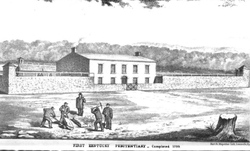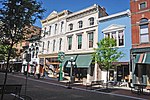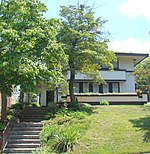Kentucky War Memorial

The Kentucky War Memorial is a memorial to Kentuckians who have died in all wars. On a high-point called the "State Mound" in Frankfort Cemetery in Frankfort, Kentucky, the memorial consists of a 65-foot-tall monument erected in 1850, nine low stone monuments built in a semi-circle, and two low straight monuments. The 1850 monument honors men who died up until 1850 and it lists the battles and the officers who fell. The semi-circular area to the south of the tall monument lists the wars, and the straight monuments list the names of all of Kentucky's fallen. The wars mentioned include: War of Independence, War of 1812, the Texas War of Independence, the Mexican War, Civil War, Spanish–American War, World War I, World War II, Korean War, Vietnam War, and Persian Gulf War.: 134 In 1848, an act passed by the state legislature appropriated $15,000 for its construction. The 65-foot-tall granite monument, topped by a statue of Victory, was unveiled in 1850. The monument was erected to stand over the graves of 17 Kentucky soldiers who had fallen at the Battle of Buena Vista. Their interment in Frankfort Cemetery on July 20, 1847, was marked by a eulogy from John C. Breckinridge, a supporter of the war. According to a popular story, this mass funeral inspired Mexican-War veteran, Theordore O'Hara, to pen his famed poem, "Bivouac of the Dead". However, O'Hara was still with the army in Mexico in July 1848.
Excerpt from the Wikipedia article Kentucky War Memorial (License: CC BY-SA 3.0, Authors, Images).Kentucky War Memorial
Old Glenns Creek Road, Frankfort
Geographical coordinates (GPS) Address External links Nearby Places Show on map
Geographical coordinates (GPS)
| Latitude | Longitude |
|---|---|
| N 38.193611111111 ° | E -84.864722222222 ° |
Address
Kentucky War Memorial
Old Glenns Creek Road
40601 Frankfort
Kentucky, United States
Open on Google Maps







